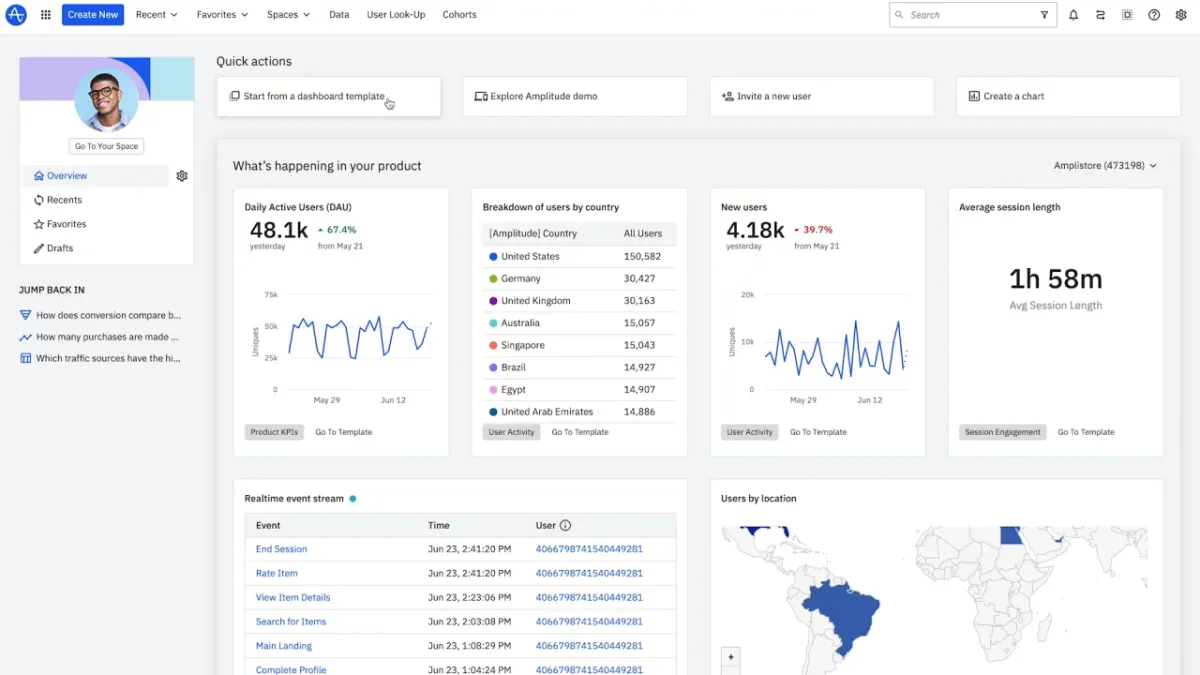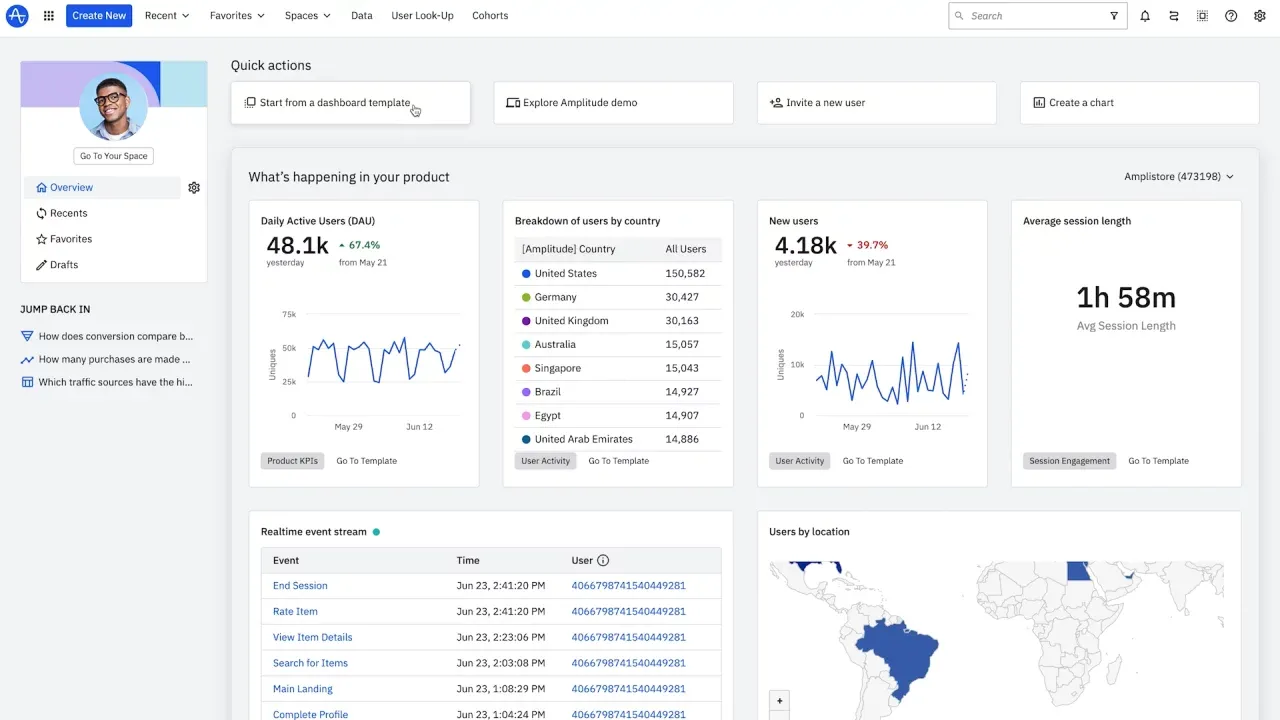Amplitude for Product Insights
Amplitude is a dominant player in the product analytics space that arms digital teams with deep behavioral insights. This review examines Amplitude's capabilities for understanding users, finding growth opportunities, and optimizing experiences.

Amplitude is one of the leading product analytics platforms used by thousands of companies to understand user behavior and optimize their digital products. I've been using Amplitude since 2018 in a mix of B2c and B2B startups from Pre-Seed to Series D stages. Founded in 2012, Amplitude is a well-funded startup and now publicly traded company that has become a dominant player in the product insights space.
In this review, I aim to provide an in-depth look at Amplitude from the perspective of a product leader considering it for their team. As product managers, having access to quality data on how users interact with our products is invaluable. Platforms like Amplitude give us powerful insights to understand our customers, identify opportunities to improve experiences, and demonstrate the impact of our work.
Throughout this article, I will give an overview of Amplitude's core capabilities, evaluate its key benefits and potential drawbacks, discuss relevant use cases, and provide a recommendation on when Amplitude is a good fit for a product analytics solution. The goal is to equip product managers with the information needed to make an informed decision about adopting Amplitude.
I've used Amplitude at my last three startups and I can't imagine turning to another platform for product analytics and insights.

Amplitude
Amplitude is a product analytics platform purpose-built to help PLG teams understand user behavior, optimize product experiences, and drive growth.
Key Takeaways
- Amplitude provides in-depth behavioral analytics to optimize user experiences across the product lifecycle.
- Core capabilities like user journeys, funnels, segmentation, and retention analysis deliver actionable insights.
- For products with complexity and scale, Amplitude should be evaluated as a leading product analytics solution.
Pricing
- FREE for the 100k monthly tracked users – perfect for startups
- Platform and event-based fees – expect to pay $25-125k depending on your industry (B2B/B2C), event volume, and add-ons
Core Capabilities
Amplitude provides several major benefits that make it a leading choice for product analytics:
- Deep understanding of user journeys
Amplitude excels at mapping out how users navigate through your product. You can analyze key events to pinpoint where users are dropping off or running into friction. These insights unlock opportunities to optimize user workflows. - User segmentation
Cohorts and custom segments help you slice and dice your users to analyze specific groups. For example, you can target high-value customers or those at risk of churning. Segmentation enables more personalized experiences. - Conversion tracking
Detailed conversion funnels show how well users move through sign-up, purchase, and other processes. You can identify leaks in the funnel to improve conversion rates. - Retention analysis
Cohorts and retention reports give visibility into how well you are retaining users over time. Drops in retention signal issues to address through engagement campaigns or product improvements. - Flexible implementation
Amplitude offers APIs, SDKs, and turnkey integrations so you can collect event data from across your product stack. This flexibility is essential for comprehensive insights. - Scalability
The platform scales with your product growth and data volumes over time. Pricing tiers accommodate businesses of all sizes and stages.
Amplitude equips product teams with actionable, behavioral data to understand their users and systematically improve experiences and outcomes. These capabilities make a compelling case for adoption.
Potential Drawbacks
While Amplitude offers powerful analytics capabilities, there are some potential drawbacks to consider:
- Implementation requires engineering work - To implement Amplitude tracking appropriately across your product and infrastructure requires upfront technical work. This can take engineering time away from other priorities.
- Advanced functionality has a learning curve - While core reporting is accessible, advanced features like predictive analytics, attribution, and machine learning require deeper expertise to extract value.
- Out-of-the-box insights are limited - Amplitude provides the data, but further analysis and context are needed to derive insights. Less sophisticated users may struggle without additional support.
- Lacks identity resolution - Unlike Customer Data Platforms, Amplitude does not stitch together user identities into unified profiles. This limits cross-channel analysis.
- Costs scale with event volume - The pricing model is highly dependent on monthly event volume. Costs can rise significantly as products and data scale up.
While these drawbacks should be evaluated, they can be mitigated through proper planning, training, and resource allocation. For most product teams, the benefits outweigh the limitations. But organizations should go in with eyes wide open.
Use Cases
Here are some common use cases where Amplitude delivers high value:
- Improving onboarding and adoption - Using behavioral data to optimize the initial user experience, in-app messaging, prompts, and transitions to activate new users.
- Increasing conversions - Identifying leaks in key funnels like sign-ups, purchases, and subscriptions to improve completion rates.
- Reducing churn - Segmenting at-risk users based on engagement and usage to target retention campaigns and in-product experiences.
- Optimizing feature usage - Pinpointing low adoption features and workflows to focus enhancements and in-context education.
- Segmenting users - Building custom segments to deliver tailored experiences to high-value users versus potential detractors.
- Running experiments - Leveraging A/B testing tools to trial and measure new features, interfaces, campaigns, and algorithms.
- Monitoring trends - Tracking KPIs and user behavior over time to spot changes and ensure initiatives are moving the needle.
The platform is versatile enough to support a wide range of use cases. Product teams can apply Amplitude on both strategic initiatives and tactical optimizations.
Conclusion & Recommendation
Amplitude provides powerful product analytics capabilities that enable teams to better understand their users and optimize experiences. The platform excels at mapping user journeys, identifying optimization opportunities, segmenting audiences, and tracking growth trends.
For any digital product, having access to high-quality behavioral data should be considered essential, not optional. While limitations like costs and implementation effort should be evaluated, the benefits Amplitude unlocks far outweigh the drawbacks for most organizations.
Amplitude is likely overkill for smaller or simpler products. But for products with significant complexity, scale, and ambition, Amplitude can provide invaluable insights. For enterprise companies and fast-scaling startups, Amplitude should be seriously considered as a leading option.
While product analytics platforms require an investment, they pay dividends in the form of better customer experiences, faster growth, and data-driven decision making. For product teams ready to level up their analytical capabilities, I recommend giving Amplitude strong consideration.
More Analytics Tools


